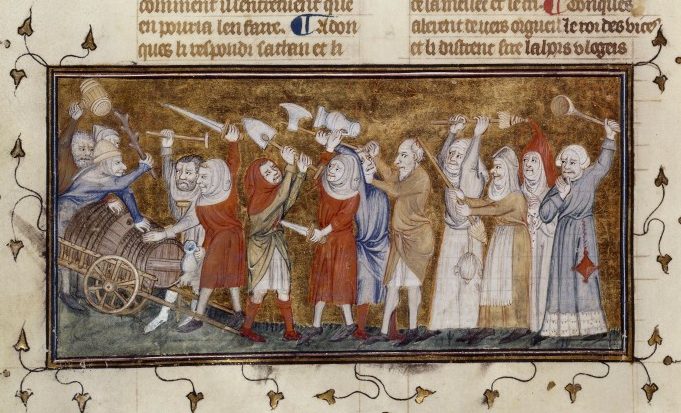Clothing and Accessory Guidelines for a Living History Event
A few years ago, we found ourselves in need of some basic do’s and don’ts for personal clothing and accessories (henceforth ‘kit’ or ‘gear’) for a living history event, the St Ives Medieval Faire. The focus is much broader than our group’s 1376 target, being 1300-1415[1].
Naturally the answer to ‘what should I wear to accurately portray a fourteenth-century person?’ must be ‘it depends’. In order to be more helpful, we make gross generalisations.
We wanted the guidelines to be as brief and clear as possible. We targeted common ‘re-enactorisms’ and tried to allow easy sifting of ‘off the shelf’ gear.
I’m publishing them here in case they are of use to a broader audience, and to submit them for criticism. If any of the ‘acceptable’ or ‘unacceptable’ items can be demonstrated to be common in the 1300’s, we’d love to know, in the comments below, or here. Likewise, if you believe we wrongly consider anything ‘desirable’, we’d love to know.
These were formulated for fourteenth century groups at St Ives Medieval Faire to regulate standards amongst themselves. They are not official rules of the St Ives Medieval Faire, and are subject to change.
General
The event aims to entertain and educate guests in an immersive historical experience. The following guidelines are here to help you contribute to this experience without unwittingly standing out. Where these brief guidelines are ambiguous or unhelpful, remember this overall goal.
Your appearance should not surprise the person you are portraying if they were to stand 5 metres away. In material and construction, your clothes should look genuine and represent common forms for the period.
- Sunglasses and eyeglasses should not be worn. Hats, hoods, and veils should be used to shade the eyes and contact lenses for correcting vision.
- Hair styles and colours which are not medieval should be covered.
- Piercings, tattoos and other non-medieval body modifications should be concealed.
- Outer garments should be made from wool or a fabric resembling wool.
- Silk may be appropriate for some portrayals.
- Shoes should be of turn-shoe construction and purpose built for medieval re-enactment.
Portrayals
Most of us will be portraying ‘commoners’ – people who were vassals of a local lord, members of a household/affinity, soldiers etc. Some people will hopefully be doing specialised portrayals of squires, knights, noble ladies or others with distinctive clothing and accessories. If that’s you, please keep us informed of what you’re planning (it’s embarrassing to have 6 John of Gaunts show up) but otherwise disregard the commoner’s kit guides and fall back on the event guidelines above.
If you are not sure what to wear, please stick to the guidelines below.
Men’s Civilian Commoner’s Clothing
Desirable
Aim to make or acquire kit like this
- Wool suit comprised of hood and cote (long sleeve tunic)
- Footed or stirruped wool hose, either top-pointed or split hose
- Linen shirt and breeches/braies/breechcloth
- Sewn turn-shoe low shoes or ankle boots with short to moderate toe points
- Leather soled hose in place of turn-shoes
- Girdle (belt) of narrow leather or woven wool/linen/silk
- Flat leather belt purses, hanging purses, leather accessory cases and other period belt accessories
- Knives, daggers and swords in scabbards
- All visible sewing hand worked
Acceptable
You may bring it until you have something better, but please don’t make or buy things like this
- Wool blend or synthetic suits strongly resembling wool
- White cotton shirts and breeches/braies/breechcloth/‘boxer-braies’ (white linen drawstring shorts)
- Krakow/Poulaine long toe shoes
- Purpose-built re-enactment shoes/boots, without a raised heel, stitched, glued, or nailed construction
- Wide leather belts (wider than ~40mm)
- Visible machine sewing
Unacceptable
Please don’t bring these things to the event. Please don’t ask if these things are acceptable
- Cotton or linen outer garments
- Coloured visible undergarments
- Trews, trousers or C15th joined hose
- Modern shoes or boots – thick soles, raised heels, any modern construction visible
- Tall boots, over mid calf, inc buccaneer boots, hunting boots, ‘Gaston Phebus’ boots
- Visible modern socks
- Knives, daggers or swords with uncovered blades
- Sword rings, tankard hangers, belt slide favours and any other non-period belt accessories
- Ring belts (tongue-less buckles)
- Visible machine embroidery
Women’s Civilian Commoner’s Clothing
Desirable
Aim to make or acquire kit like this
- Wool dress with long sleeves and skirt
- Footed or stirruped wool knee stockings
- White linen smock (underdress)
- Sewn turn-shoe low shoes or ankle boots with short to moderate toe points
- Girdle (belt) of narrow leather or woven wool/linen/silk
- Flat leather belt purses, hanging purses, leather accessory cases and other period belt accessories
- Knives in scabbards
- All visible sewing hand worked
Acceptable
You may bring it until you have something better, but please don’t make or buy things like this
- Wool blend or synthetic dress fabric strongly resembling wool
- Modern undergarments not visible or evident through outerwear
- Purpose-built re-enactment shoes/boots, without a raised heel, stitched, glued, or nailed construction
- Wide belts (wider than ~40mm)
- Visible machine sewing
Unacceptable
Please don’t bring these things to the event. Please don’t ask if these things are acceptable
- Cotton or linen outer garments
- Coloured smocks (underdresses)
- Visible or evident modern undergarments
- Visible modern trousers, leggings or stockings
- Modern shoes or boots
- Ring belts (tongue-less buckles)
- Visible machine embroidery
[1] What’s that? The C14th ended in 1399? Inconceivable!

Comments are closed.